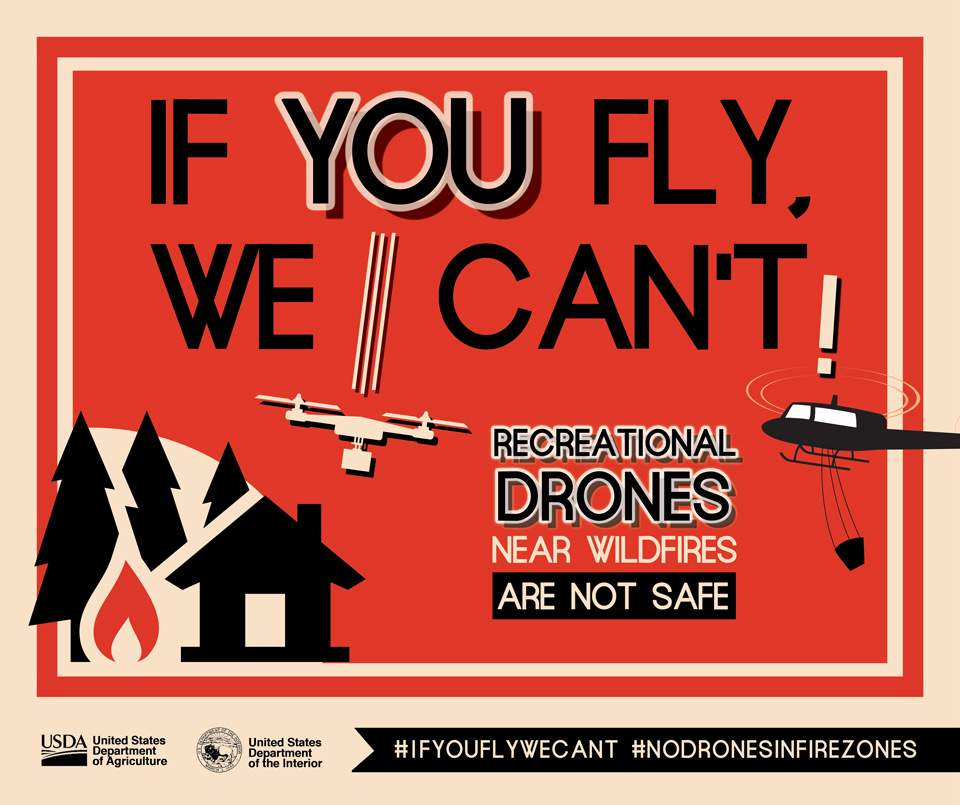
July 12, 2021 - VALLEJO, Calif. — USDA Forest Service Pacific Southwest Region reminds all citizens not to fly Unmanned Aircraft Systems (UAS or drones) near wildfires. Recreational UAS flights are prohibited when Temporary Flight Restrictions (TFR’s) are in place during an on-going incident.
Not all wildfires have a TFR over the incident and we would like to remind citizens to not interfere with aerial firefighting aircraft at any stage of the incident. This requirement follows Federal Aviation Administration (FAA) policy and best practices to avoid mid-air collisions with firefighting aircraft, risks to on-the-ground firefighters, and hampering the effectiveness of wildfire suppression operations.
Unauthorized drone flights over or near wildfires by members of the public are a significant problem throughout the United States. In 2020, there were 21 documented reports of drone incursions, the same number recorded in 2019.
Aerial firefighting aircraft, including air tankers, lead planes, and helicopters, fly at very low altitudes, just hundreds of feet above the ground, and in the same airspace as drones. This creates the potential for a mid-air collisions and pilot distraction that may result is a serious or fatal accident.
Individuals who have been determined to have endangered manned aircraft or people on the ground with a UAS and/or interfered with wildfire suppression may be subject to civil penalties, including fines of up to $25,000, and potentially criminal prosecution.
If an unauthorized, unannounced, or unidentifiable drone is detected flying over or near a wildfire, fire managers may have to ground all aerial firefighting aircraft until they can confirm that the drone has left the area and they feel confident that the airspace is safe again. This can cause wildfires to become larger, more costly, and to unduly threaten lives, property, and natural and cultural resources.
Individuals who fly drones without prior authorization over wildfires may be violating federal, state, and/or local laws, regulations, and ordinances. All unauthorized drone flights over wildfires will be reported to the Federal Aviation Administration (FAA) and law enforcement agencies.
Media outlets that want to use drones as part of their coverage should contact the fire’s Public Information Officer or Incident Commander. Contact information for wildfires is available on InciWeb at https://inciweb.nwcg.gov/, or call 208-387-5050. Additional information is available on the FAA website at https://www.faa.gov/uas/faqs/. In order to discourage amateur drone flights and video, media outlets are asked to not use footage shot by members of the public.
For more information on drone use on Forest Service land, please visit:
https://www.fs.usda.gov/managing-land/fire/uas/if-you-fly.
The Forest Service manages 18 National Forests in the Pacific Southwest Region, which encompasses over 20 million acres across California, and assists State and Private forest landowners in California, Hawaii and the U.S. Affiliated Pacific Islands. National forests supply 50 percent of the water in California and form the watershed of most major aqueducts and more than 2,400 reservoirs throughout the state. For more information, visit www.fs.usda.gov/R5.
Source: USFS








